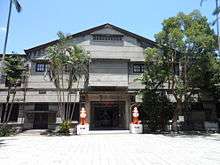Design museum
A design museum is a museum with a focus on product, industrial, graphic, fashion and architectural design. Many design museums were founded as museums for applied arts or decorative arts and started only in the late 20th century to collect design.
The first museum of this kind was the Victoria and Albert Museum in London. In Germany the first museum of decorative arts was the Deutsches-Gewerbe-Museum zu Berlin (now Kunstgewerbemuseum), founded in 1868 in Berlin.[1]
Also some museums of contemporary or modern art have important design collections, like the MoMA in New York, the Centre Pompidou in Paris. A special concept has been realised in the Pinakothek der Moderne in Munich, in which four independent museums cooperate, one of them being Die Neue Sammlung – the largest design museum in the world.
Today corporate museums like the Vitra Design Museum, Museo Alessi or Museo Kartell play an important role.
List of design museums
- Archivo Diseño y Arquitectura, Mexico City
- Design Museum of Chicago, Chicago
- Design Museum Dharavi, India
- Cooper Hewitt, Smithsonian Design Museum, New York
- Design Museum Gent, Belgium
- Art & Design Atomium Museum, Brussels
- Design Museum, London
- Danish Museum of Art & Design, Copenhagen
- Swedish Centre for Architecture and Design, Stockholm
- Swedish Design Museum (virtual), Sweden
- Die Neue Sammlung, Germany
- Leipzig Museum of Applied Arts, Germany
- Bauhaus Archive, Berlin
- Martin-Gropius-Bau, Berlin
- Kunstgewerbemuseum Berlin, Germany
- Museum für angewandte Kunst Frankfurt, Germany
- Museum für angewandte Kunst Cologne, Germany
- Museum für angewandte Kunst Wien, Austria
- Museum of Decorative Arts in Prague, Czech Republic
- Museum of Design Atlanta, Atlanta
- Museum of Applied Arts (Belgrade), Serbia
- Museum of Applied Arts (Budapest), Hungary
- Museum of Arts and Design, New York
- Powerhouse Museum, Sydney
- Röhsska Museum, Gothenburg, Sweden
- SONS Museum, a museum dedicated to shoe design, Kruishoutem, Belgium
- Singapore City Gallery, Singapore
- Red Dot Design Museum, Singapore
- Stieglitz Museum of Applied Arts, Saint Petersburg, Russia
- Triennale (Milan), Italy
- 21 21 Design Sight, Tokyo
- Design Museum Holon, Tel Aviv, Israel
- Design Exchange, Toronto
- Taiwan Design Museum, Taipei, Taiwan
- Wolfsonian-FIU
- Victoria and Albert Museum
- V&A Dundee, Dundee, Scotland
References
- Dimaki, Angeliki; Dimakis, Christos E. (May 2006). "From a physical design museum towards a virtual design museum: Or how museology, new technologies and design meet" (PDF). 5th Nordcode Seminar and Workshop, Oslo, May 10–12, 2006. Nordcode. Retrieved 2008-06-10. External link in
|publisher=(help)
